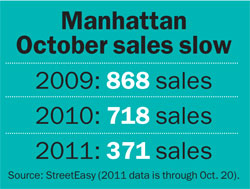
The autumn leaves are turning, and New York’s fall real estate market may be changing, too.
Autumn has traditionally been one of the busiest times of the year for residential sales, along with spring — the season of tax refunds and bonuses.
But real estate brokers say the fall selling season has declined in importance over the past few years, thanks to factors like the city’s dependence on bonuses and later-than-usual Jewish holidays.
It’s too soon to say whether the shift is permanent, but some say it could be a long-term trend rather than a temporary side effect of the topsy-turvy, post-Lehman economy.
Data shows that fall sales activity has gradually declined over the past few years. According to research compiled by the listings website StreetEasy, 535 Manhattan properties went into contract in September, down from 571 in the same month of last year and 724 in September 2009. Similarly, there were 868 Manhattan sales in October 2009 and 718 in the same period of 2010, but only 371 sales by press time last month.
By contrast, spring now appears to have gotten busier. In March 2009, for example, 609 units went into contract, according to StreetEasy. A year later, 1,025 units were sold in the same month, and March of this year saw 1,010 sales.
Various economic factors and world events obviously cause the patterns of sales activity to change somewhat from year to year. But real estate pros say sales activity now appears to be more consistently spring-centric.
“The market seems to be more front-end-loaded now,” said real estate appraiser Jonathan Miller, the CEO of Miller Samuel.
There are a number of possible explanations for this phenomenon.
One major factor is “how important bonuses are,” Miller said. He noted that Wall Street bonuses increased throughout the 2000s, along with the expanding credit bubble and housing boom.
Bonus dollar amounts have dropped somewhat in response to today’s rocky economic climate, but Wall Streeters are still accustomed to receiving a large payout in January or February of each year. (Financial-sector workers generally find out the amount of their bonus in December, but don’t get the cash for several months.)
Home sellers, in turn, put their properties on the market around that time.
“You see inventory ramp up on Jan. 1, because the sellers anticipate this,” Miller said. As a result, “the fall market takes a backseat to the spring market, and the spring market has been expanded.”
Another factor is the increasing number of families choosing to stay in the city rather than move to the suburbs. Parents with children are more likely to buy in the spring, so they can spend summer vacation with the kids and be settled by the time the school year starts, brokers said.
“The school calendar influences the traffic of people looking,” said Donna Olshan of Olshan Realty. “This is a city where people work hard, and look to evacuate on weekends and school holidays.”
That effect of these factors is particularly pronounced this year, brokers said, because of the weakness at the lower end of the real estate market. Due to the volatile economy and perceived lack of job security, cash-strapped singles or couples are less likely to buy apartments, while demand from growing families in need of larger apartments has stayed strong, said Doug Perlson, CEO of the Manhattan-based online brokerage RealDirect.
The timing of the fall Jewish holidays also impacts the relative importance of the fall selling season. In some years, Rosh Hashanah is celebrated just after Labor Day; this year, it fell on Sept. 29.
Every year, “the volume of activity declines in the two weeks when there are Jewish holidays,” Olshan said. During the week of Rosh Hashanah this year, there were only three sales of Manhattan homes priced above $4 million, down from nine the week before, according to Olshan’s weekly Luxury Report.
When this lull comes midway through autumn, it tends to disrupt the momentum of the sales market. That’s because brokers have less time to close deals before Thanksgiving, when the holiday season again distracts New Yorkers from real estate, Olshan said.
“Selling time in the fall season has already been somewhat marginalized by the spring, and now you cut into selling time even more [with the Jewish holidays],” Miller said.
Sellers are also nervous about listing their homes in the fall, Perlson said, because if the transaction falls through in today’s difficult mortgage climate, they face the prospect of putting the home back on the market during the slow winter season.
“If your deal falls through, it’s Thanksgiving, and you are not on the market again until after the New Year,” Perlson said. “This risk may be pushing some sellers to simply wait until after the New Year, when there is a longer season.”
Noah Rosenblatt, founder of the real estate analytics and consulting firm UrbanDigs, said it’s too soon to determine if this is a long-term change in the patterns of New York real estate.
But it shows no sign of abating yet, if bonuses are any indication.
“There’s no indication that in the next five years there’ll be any big changes [to bonuses],” Miller said. “At least in the near term, they will remain a significant part of our regional economy.”
